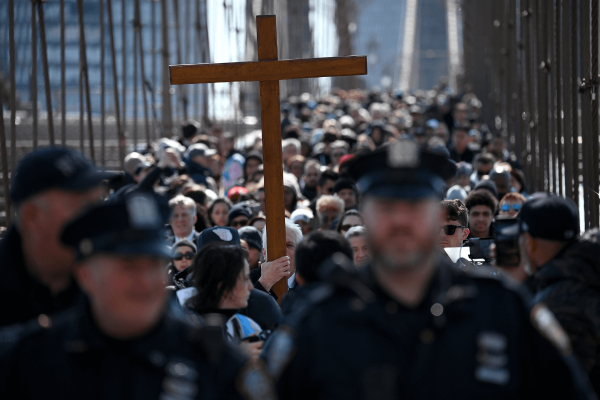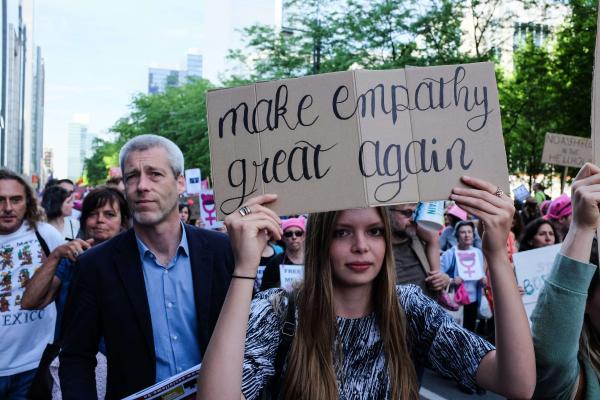Martin Luther is such a towering figure in German history that it’s no surprise Adolf Hitler’s Third Reich exploited his name whenever it could.
Most visitors to events in Germany marking this year’s 500th anniversary of the Reformation, however, probably didn’t expect to find an exhibition setting out just how extensively the Nazis used Luther to justify their anti-Semitism and nationalism.
To dramatize the connection, the exhibition “Luther’s words are everywhere … ” is located in the Topography of Terror, a central Berlin museum about Nazi repression methods that was built where the headquarters of the Gestapo secret police and SS paramilitary force once stood.
The caption under a portrait of Luther in the Nazi propaganda weekly Der Stürmer, reproduced on a panel at the exhibition, comes right to the point. Calling him a “fighter against the Jewish spirit in the Christian Church,” it says: “Dr. Luther is one of the greatest anti-Semites in German history.”
Another panel shows a poster urging Berlin Lutherans to vote for the pro-Nazi “German Christians” in local church elections in July 1933, only months after Hitler came to power. At the top are both the Christian cross and the swastika, which is called the “hooked cross” (Hakenkreuz) in German.
“We merge Christ’s cross with the hooked cross,” it declares. Dripping with Nazi terminology, it says Christianity should have nothing to do with anything opposed to the German people and their race.
The title of the exhibition comes from a 1937 quote by the Lutheran theologian Dietrich Bonhoeffer: “Luther’s words are everywhere, but twisted from truth into self-deception.” Bonhoeffer was executed as an anti-Nazi conspirator one month before World War II ended in 1945.
“They very clearly used Luther’s writings that had all this anti-Semitism in them to support their cause,” he told RNS, noting the treatise called for Jews to be expelled from German cities, synagogues to be burned down and rabbis forbidden to preach.
“Luther is particularly tragic in this sense” since he had rejected anti-Semitism in earlier writings, Hendel said. But Luther always believed Jews should be converted and he gradually lost patience when they did not embrace Christianity.
The reformer’s 1543 treatise was all but forgotten for generations until 19th-century German scholars included it in what is known as the Erlangen edition of his complete works. “It’s through that reality that Hitler and his supporters knew about it,” Hendel said.
The Nazis marked the 450th anniversary of Luther’s birthday in November 1933 with a nationwide “German Luther Day,” in which the main speaker praised Luther’s “ethno-nationalist mission” and called for “the completion of the German Reformation in the Third Reich.”
The following year, they celebrated the 400th anniversary of his groundbreaking translation of the Bible into German for, as they put it, “a healthy people committed to their own kind.”
In 1938, Hitler’s propagandists highlighted the fact that the infamous Kristallnacht (Night of Broken Glass) of Nov. 9-10 — when Nazis burned synagogues and smashed the windows of Jewish-owned shops, leaving more than 1,000 synagogues ablaze or smoldering — fell on the reformer’s birthday.
Citing this pamphlet in its review of the exhibition, the Berlin tabloid newspaper B.Z. said: “This instrumentalization must not be ignored amid all the hero worship in this Luther year.”
The exhibition also documents the Third Reich’s crackdown on the Confessing Church, the Protestant minority that opposed Nazism, and the government’s hand in helping to build or renovate more than 1,000 Protestant church buildings during the Nazi period.
Thomas Albert Howard, professor of humanities and history at Valparaiso University in Indiana, said the first two Reformation centennials were strictly religious, but interpretations of Luther changed in the 19th century.
“This is where you get the two major strands,” he said. “One is the liberal Luther, whose reforms are seen as leading to progress and the modern age, and the other the nationalist Luther, whose Bible translation helped shape the modern German language and identity.”
By the 400th anniversary of his birth in 1883, the ceremonies exuded “a worrisome and pungent nationalism” that continued when Imperial Germany marked the 1917 Reformation centennial during World War I.
“The German Protestant church was split in two between the ‘German Christians,’ who were more sympathetic to National Socialist ideals, and the Confessing Church — typified by people like Dietrich Bonhoeffer — who were very critical of the marriage of Christianity and Nazism,” he said.
“The Nazis wanted to instrumentalize the church — they weren’t gung-ho about Martin Luther per se.”
Despite his anti-Semitic writings, Luther couldn’t be called a Nazi either, Hendel insisted.
“He was not a Nazi anti-Semite, he was a religious anti-Semite,” he said, explaining that Luther opposed Jews not as an ethnic group but because they refused to convert.
Hendel stressed that Lutheran churches have since firmly rejected Luther’s anti-Semitic writings and asked for Jews’ forgiveness.
“However, anti-Semitism is still well and alive, as we see in our own time now with the neo-Nazi stuff and Charlottesville and all those kinds of reality,” he added. “We have to be very critical.”
Got something to say about what you're reading? We value your feedback!






